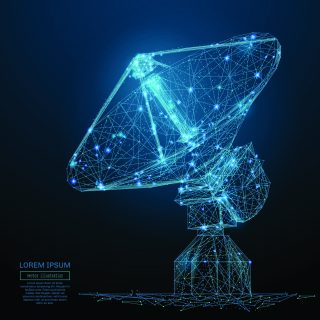Science Project Outlines
Curtin Institute of Radio Astronomy offers four streams of science projects

Accretion, jets and slow transients
Project lead: Professor James Miller-Jones
Staff: Dr Gemma Anderson, Dr Arash Bahramian, Dr Adelle Goodwin, Dr Steve Prabu
Students: Shih Ching Fu, Dylan Grigg, Brendan Hennessey, Tyrone O’Doherty, Alessandro Paduano, Jun Tian, Callan Wood
This project seeks to investigate some of the most extreme environments in the universe, using powerful, explosive events to probe physics under conditions of high energy, strong gravity, and/or strong magnetic fields. We use radio observations to determine how energy and matter is fed back into the surrounding environments during cataclysmic events such as the deaths of stars in supernovae or gamma ray bursts, the merging of two neutron stars, or the accretion of gas onto a supermassive black hole as it rips apart a passing star that wanders too close.
We also study similar processes in stellar-mass black holes accreting from a binary companion star in our own Milky Way galaxy, or in their less massive neutron star or white dwarf binary analogues. This allows us to determine how jets are launched in real time, and how the nature of the accreting source affects their properties.
For this project, we use observational data from right across the electromagnetic spectrum, and take advantage of the new insights provided by the recent advances in multi-messenger astrophysics, from gravitational waves to neutrinos.
Finally, we use the techniques developed to detect new transient and variable radio sources to track satellites and space debris in low-Earth orbit, as they reflect FM-band radio signals back down to Earth, which can then be detected by the MWA.

Epoch of Reionisation Science
Project lead: Professor Cathryn Trott
Staff: Dr Nichole Barry, Dr Anshu Gupta, Dr Chris Jordan, Dr Jack Line, Dr Ben McKinley, Dr Ridhima Nunhokee, Ms Teresa Slaven-Blair
Students: Kariuki Chege, Jaiden Cook, Ravi Jaiswar, Mike Kriele, Aishwarya Selvaraj, Jishnu Thekkeppattu, Himanshu Tiwari
The Epoch of Reionisation (EoR) project aims to untangle the evolution of the universe during its first billion years. This will be achieved through observations of the redshifted hydrogen line signal, emitted by the neutral hydrogen gas that was present in abundance during this epoch.
Structural features of the formation of the first ionising sources during the EoR are traced by the neutral hydrogen gas signal. The spatial and temperature distribution of the hydrogen line observations allows us to probe this evolution, and explore the growth of structure during the cosmic dawn.
Radio telescopes such as the Murchison Widefield Array (MWA) and future Square Kilometre Array (SKA) located in Western Australia will play a key role in detecting this hydrogen line signal and understanding the mysteries of the early universe.

Extragalactic radio astronomy
Project lead: Dr Natasha Hurley-Walker
Staff: Dr Sam McSweeney, Dr Kat Ross, Dr Nick Seymour
Students: Joe Grundy, AJ Hedge, Sean Patterson, Flora Petrou, Silvia Mantovanini, Brandon Venville, Angelica Waszewski
This project seeks to leverage the wide field of view, broad frequency coverage, and excellent surface brightness sensitivity of the MWA to explore radio-emitting sources in the distant universe. It leverages state-of-the-art low-frequency radio sky surveys such as GLEAM (the GaLactic and Extragalactic All-sky MWA survey) and its ongoing higher angular resolution counterpart, GLEAM-X, together with supporting multi-wavelength data, to study some of the largest structures in the universe, such as giant radio galaxies, galaxy clusters, and the cosmic web.
As well as studies of structure on the largest astrophysical scales, the project uses the MWA to identify much smaller sources, including some of the most distant galaxies in the universe, detecting radio waves that they emitted when the universe was just a fraction of its current age. Furthermore, by using the twinkling of radio sources seen through the solar wind, we can use the MWA, spanning only a few kilometres, to mimic a telescope one hundred times the size, and thereby identify some of the most compact low-frequency radio sources known, which are typically young supermassive black holes that have only recently begun accreting matter.
Within our own Galaxy, we can use the sensitivity of the MWA to old, diffuse radio emission to identify previously undiscovered supernova remnants – the few thousand year-old remains of stars that ended their lives in cataclysmic explosions known as supernovae. The wide field of view of the MWA also yields a perfect machine for hunting for strange new transient radio sources that appear and disappear. Our group has detected new types of Galactic radio transients, such as unusually slow repeating sources, that may be ultra-long period magnetars.

Pulsars and Fast Transients
Project lead: Dr Ramesh Bhat
Staff: Dr Amir Forouzan, Dr Marcin Glowacki, Dr Clancy James, Dr Bradley Meyers, Dr Sam McSweeney,
Students: Wayne Arcus, Garvit Grover, Mawson Sammons, Danica Scott, Susmita Sett, Nick Swainston, Ian Kemp
This project explores the universe at the highest time resolution, studying compact sources of radio emission that produce bursts or pulses of radio waves that can last for less than a millisecond. Having developed the capability of the MWA to study radio sources at a time resolution of less than one ten thousandth of a second, we can use this to study the properties of pulsars – rapidly spinning neutron stars that emit regular pulses of radiation, with a stability better than the earth’s best atomic clocks. We are conducting an MWA survey of the entire southern sky to detect new pulsars, and to study known systems, aiming to better understand how these exotic objects produce their radio emission.
This project also uses the ASKAP radio telescope at the Murchison Radioastronomy Observatory to detect new fast radio bursts (FRBs), and to ascertain which galaxies they come from. FRBs are energetic, short-duration single bursts of radio emission coming from distant galaxies, whose origin is as yet unknown. By studying how the different radio frequencies within a burst are slowed down as they travel through the tenuous gas between galaxies, we can determine the density of that gas, providing one of the few methods of probing this matter, which has hitherto remained virtually undetected. This allows us not only to weigh the universe, but also to perform key cosmological measurements. Finally, by measuring precisely where the bursts appear to come from within their galaxies, we can try to pin down what gives rise to these new and unexplained phenomena.
